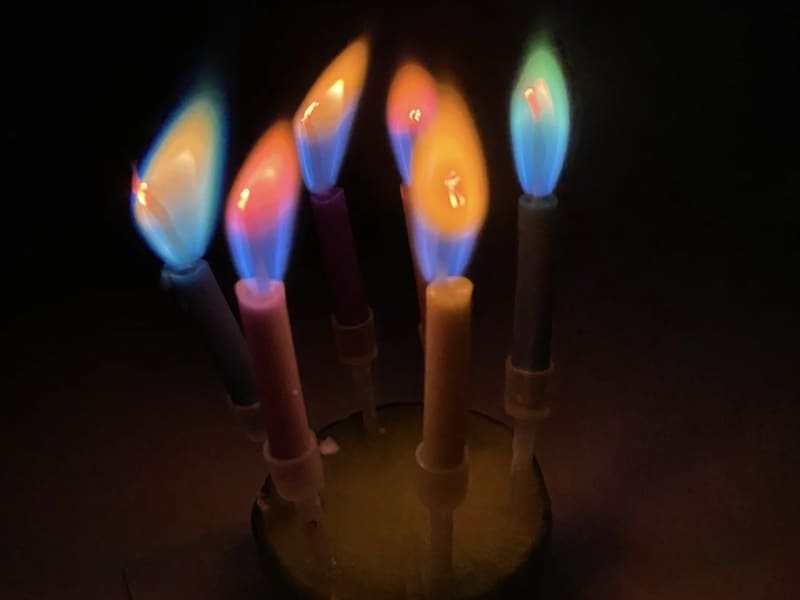Did you know that you can make different-colored candle flames? I decided to look more into the topic. It turns out there are many people confused about colored candle flames. It’s easy if you have the proper knowledge and follow instructions. Not to mention, these flames are beautiful!
You can soak your wicks in various chemicals such as Copper Chloride or Boric Acid to achieve an array of flame colors such as purple or yellow. After saturating your wicks, let them thoroughly dry before using them. Once the wicks dry, you can use them like any ordinary wick.

How Can You Change Your Flame’s Color?
You can use chemicals to change your candle flame to various colors, such as green or purple. To attain these colors, a candle wick can be soaked in multiple chemicals, such as copper chloride or boric acid.
Fire creates diverse colors when it burns at specific temperatures. Each chemical offers a distinct color due to the candle’s flame burning warmer or cooler. A standard candle flame burns around temperatures of 1,800 °F to 1,900 °F or 982 °C to 1,038 °C.
The flame’s hottest part may reach 2,550 °F or 1,400 °C. Soaking your wick in chemicals will yield candle flame temperatures of 2,400 °F to 2,700 °F or 1,315 °C to 1,482 °C.
Though it’s possible to use chemicals, we want to make sure you’re mindful of the health risks of burning chemicals, as many of them emit toxic fumes when burned.
How to Use Chemicals to Create Colored Flames
A small candle flame will not usually emit enough fumes to harm your health, as burning chemicals in a small candle flame poses fewer health risks. Though, burning chemicals in a massive fire may be a different story.
You should be safe if you’re not sticking your face directly above the candle flame and breathing in the fumes.
Using chemicals in candles is tricky, as well as posing health risks. As a result, colored flamed candles are not widely available. Once you know how to create colored flames using chemicals, you can make your own! It can be an easy process once you know what you’re doing.
1. Get Your Chemicals
You can find various common chemicals, like sodium chloride or magnesium sulfate, from numerous retailers, such as Walmart or CVS. Many of these chemicals are simply table salt or Epsom salt, which is available practically anywhere.
Although, you may need to purchase some less common ones from online retailers or manufacturers such as Amazon or lab chemical suppliers. Getting your chemicals is the hard part of changing your candle flame’s color. Once you pass this step, it is relatively easy from here on.
2. Dissolve Your Chemicals
Many chemicals will come in powder form. In that case, you should dissolve the chemical powder in water first, according to the chemical’s direction. Add the specified amount of powder and water to a small bowl and stir until fully dissolved. The water should be mostly clear with no visible chunks.
If you are using liquid chemicals, you can skip this step. Although, check your chemical’s packaging to ensure it does not need diluting. Dilute your chemicals accordingly for the most promising results.
3. Submerge Your Wick
Once your powder chemicals have fully dissolved in the water, place your wick into the chemical water mixture. Ensure the wick is totally immersed in the liquid for the best results. If your wick is partially submerged in the chemical mix, it may alter your final result.
Wicks tend to float as well; you may want to find something, such as a paperweight, to hold the wicks under. Ensuring your wick is fully submerged is a vital step of the making of colored flames process.
4. Soak the Wick for 12 to 24 Hours
Another vital step is soaking your wick for at least 12 hours and up to 24 hours. This will ensure your wick is totally saturated in the liquid.
A saturated wick ensures the chemical has fully absorbed into your wicks, providing vibrantly colored flames. A successfully soaked wick will burn a deep color with a perfectly sized flame.
5. Hang Your Wick to Dry
You must let your wicks dry before using them in a candle. You can do this using a clothes rack or line and clothes pins. Ensure the wick hangs right side up and dries for at least 2 to 3 hours. Your wick must be completely dry before using them in a candle.
A partially dry wick can cause your candle to cure wrong. A faulty cured candle can have air bubbles or gaps and burn improperly.
6. Make Your Candle
When your wicks have completely dried, you can make your candle! You can make your candles as you typically would with a standard wick.
First, attach your wick to the bottom of your container. Then, pour your wax at the proper pouring temperature, according to your wax’s directions. Remember to center your wick using a centering device.
Making candles with chemical-soaked wicks can be as simple as making a regular candle, with a few extra steps. However, it provides you with a beautiful ambiance candle.
What Chemicals Produce Different Colored Flames?
Now you know how to use the chemicals to change your flame colors, what chemicals can you use? You have myriad options, such as lithium chloride or calcium carbonate.
| Flame | Chemical Name |
| Blue Flame | Copper Chloride |
| Purple Flame | Potassium Chloride |
| White Flame | Magnesium Sulfate (Epsom Salts) |
| Orange Flame | Calcium Carbonate |
| Yellow Flame | Sodium Chloride (Table Salt) |
| Green Flame | Boric Acid |
| Red Flame | Strontium Chloride |
| Deep Red (Scarlet) Flame | Lithium Chloride |
1. Blue Flame
Copper Chloride (CuCl₂) provides a blue flame, burning at temperatures of 4,530 °F to 5,430 °F or 2,500 °C to 3,000°C. You can find this chemical in many petroleum and agricultural products as a feed additive.
CuCl₂ is moderately toxic when burned; you could compare it to campfire smoke. It can cause irritation to the throat, nose, and lungs, which can result in coughing or wheezing.
2. Purple Flame
Potassium Chloride (KCl) produces a purple flame, burning around 2,500 °F to 2,600 °F or 4,530 °C to 4,712 °C. This chemical is naturally occurring in rocks and sea salts. Commonly used in cereals, baby formulas, or snack foods, this chemical has been affirmed generally safe by the Food and Drug Administration (FDA.)
When burned, it may cast toxic fumes of Chlorine and Potassium Oxide, which can irritate your eyes, nose, throat, and lungs.
3. White Flame
Magnesium Sulfate (MgSO₄,) or Epsom salts, produces a white flame that burns around 2,400 °F to 2,700 °F or 1,315 °C to 1,480 °C.
MgSO₄ is naturally found in mineral springs, seawater, and in various minerals. Unfortunately, when burned, this chemical can emit toxic fumes. These fumes can irritate your nose and eyes with long-term exposure.
4. Orange Flame
Calcium Carbonate (CaCO3) produces a more intense orange-colored flame burning at around 2,000 °F to 2,190 °F or 1,100 °C to 1,200 °C. Found in rocks worldwide, it is a main element of eggshells and shells of marine organisms like snails.
CaCO3 is commonly used as a whitening agent in products like mouthwash or toothpaste. When burned, it can cast vapors that can irritate your lungs and respiratory passages.
5. Green Flame
Boric Acid (B(OH) 3) offers a green flame with no specific temperature. Green flames are not caused due to temperature change. Achieving a green flame is simply from the material burned vs. temperature.
This chemical is naturally occurring in the environment in water, soil, and plants. You may find it used as a fireproofing agent for wood, antiseptic, or a preservative.
6. Red Flame
Strontium Chloride (SrCl2) produces a red flame burning around 975 °F to 1,830 °F or 525 °C to 1,000 °C. The more vibrant, orange flames are around 1,830 °F or 1,000 °C.
You’ll find SrCl2 in dietary supplements for conditions like tooth sensitivity or brittle bones. When burned, SrCl2 may emit metal oxide fumes or hydrogen chloride fumes that irritate your throat and nose, resulting in coughing or wheezing.
7. Deep Red (Scarlet) Flame
Lithium Chloride (LiCl) will produce a deeper red flame. This chemical is commonly used in the production of lithium metal or as a brazing flux for aluminum car parts.
LiCl protects the aluminum from oxidizing during the brazing process. When burned, it can radiate toxic fumes that can affect your respiratory system, causing irritation to your eyes and respiratory tract.
Conclusion
Did you enjoy reading all about how to make different-colored candle flames? We love sharing this with you; feel free to share this article with your peers as well! Soaking your wick in chemicals can deliver gorgeous colored flames, but consider the health risks of inhaling the vapors these chemicals can create.

